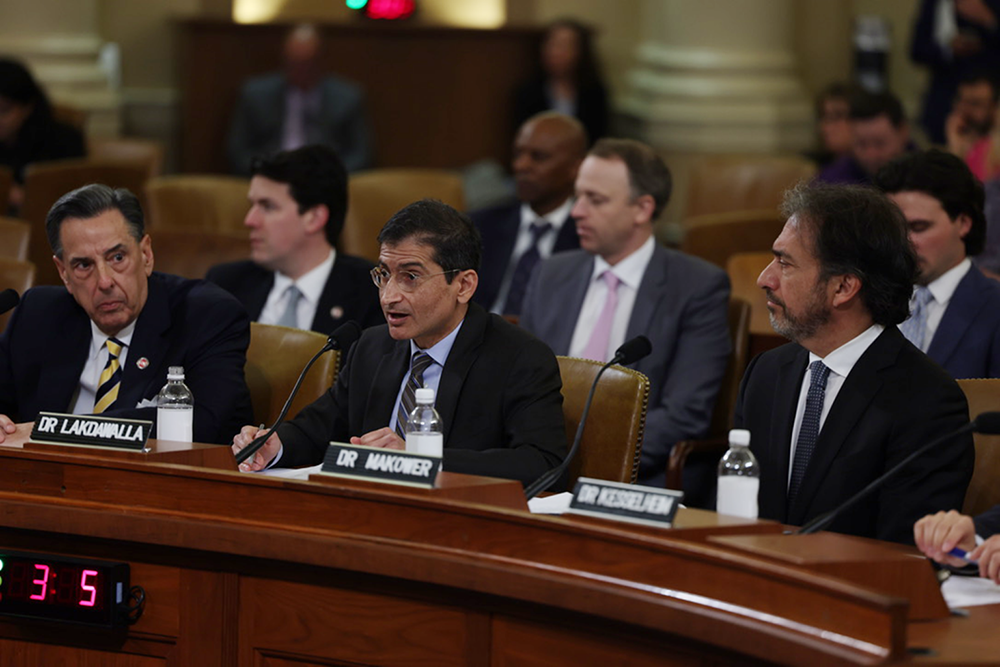Six years ago, Neeraj Sood served on a National Academies of Sciences, Engineering and Medicine Committee seeking to end Hepatitis C, a disease that kills roughly 15,000 Americans per year even though there’s a cure for it.
Sood, a professor at the USC Sol Price School of Public Policy and senior fellow at the USC Schaeffer Center for Health Policy and Economics, recommended a novel subscription payment model between governments and drug companies to make the effective – but expensive – Hepatitis C drugs affordable. He wrote op-eds, talked to state officials and traveled to Capitol Hill to bring attention to the proposal.

Yet with the exception of Louisiana, which implemented a similar plan, the idea got little traction. “Nothing happened,” Sood said.
That all changed this year when the White House came calling. Sood was invited to help develop a White House initiative to eliminate Hep C. The result: the subscription payment proposal – dubbed the “Netflix” model and pioneered by USC Price School Dean Dana Goldman – was included in President Joe Biden’s proposed budget to tackle Hepatitis C.
“It’s pretty cool that some of the ideas we started working on several years ago and persisted with are finally seeing a lot of interest among policymakers,” Sood said.
USC experts help policymakers develop solutions
Sood is hardly alone in advising policymakers lately. Researchers from the USC Schaeffer Center – a partnership between the USC Price School and the USC Alfred E. Mann School of Pharmacy and Pharmaceutical Sciences – have headed to Washington, D.C., to inform federal agencies and members of Congress. Through public hearings and private meetings, they’ve shared insights on topics ranging from biomedical innovation to drug distribution chains.
“The Schaeffer Center is one of the first places policy makers turn for out-of-the box thinking to address the most pressing health challenges,” said Goldman, who is also co-director of the Schaeffer Center. “Our work on drug policy is perhaps the most salient example.”
“We’ve been working on these topics for decades and we’ve built up an enormous amount of expertise,” said Darius Lakdawalla, a professor at the USC Price School and School of Pharmacy and research director at the Schaeffer Center. Those topics are “now becoming critical and timely policy issues, so it’s the payoff of a long-term series of research projects.”
Earlier this Spring, Lakdawalla was on Capitol Hill to testify before the U.S. House Ways and Means Subcommittee on Health. Lawmakers wanted to learn more about ways to encourage medical innovation while ensuring treatments are affordable to patients.
Sharing insights from Schaeffer Center research, Lakdawalla suggested a pricing model in which drugs are initially introduced at a lower price to gain access to Medicare coverage. If the drugs prove to be very effective, innovators could be rewarded with higher prices, Lakdawalla told lawmakers. Finally, robust generic or biosimilar competition would drive down prices once the drug loses its exclusivity, improving patient access in the long term.
“Many people think of this as a zero-sum game,” Lakdawalla said of the debate between encouraging innovation through high prices or making treatments affordable for patients. “But that’s a false distinction. We can have both.”
Shining a light on PBMs
Schaeffer Center research into the opaque drug distribution chain has garnered a lot of attention. Researchers, for example, have revealed that middlemen such as pharmacy benefit managers (PBMs) play a large role in driving up drug costs. That was the focus of recent testimony from Schaeffer Center Co-Director Erin Trish, who was a witness before the U.S. Senate Committee on Commerce, Science and Transportation.

Evidence suggests PBMs – which manage drug benefits on behalf of health insurers and employers – are leveraging their position to extract profits in a way that is detrimental to patients, Trish told lawmakers. She noted prescription drug markets are a mystery to most Americans. “Where there is mystery, there is margin,” she said.
“The dynamics and the incentives in this market are not working for many patients,” Trish said. “That has been overlooked by many policymakers for the last decade or so as we’ve talked about drug pricing reforms and issues. But that has shifted recently.”
Another Schaeffer Center researcher shining a light on PBMs is Karen Van Nuys, senior fellow and executive director of the center’s Value of Life Sciences Innovation program. In March, Van Nuys testified before the Senate Finance Committee, which is leading congressional efforts to reform PBMs. Van Nuys told lawmakers that transparency is “an essential first step.”

Master of Health Administration
Shape Systems for Healthier Communities
USC’s MHA offers unparalleled academic and professional training for careers in health administration and policy.
Find Out More“[Transparency] gives researchers like me, and regulators like the federal government the opportunity to understand the bigger picture,” she said. “But more importantly, transparency is going to provide participants in the markets with information about the true prices that they are facing and when they have [that] information, they can make better economic decisions.”
She also got a call from the White House after one of its staffers read a Wall Street Journal story quoting her about generic drug pricing. That got her a meeting in the White House, where Van Nuys explained and answered questions about PBMs. She also shared an idea to end insurance coverage for cheap generics, something that could save Medicare roughly $2.6 billion a year.

“It was definitely one of the most special things that’s happened in my professional career,” Van Nuys said. “There are a lot of academics who work on very esoteric, narrow topics, and they go really deep into stuff that the rest of the world may not be paying attention to. I’m just really cognizant of how lucky I am that this is happening before I retire.”
For Sood’s part, he has stayed in contact with the White House as the Biden Administration crafts a plan to eliminate Hepatitis C.
The possibility of ending Hepatitis C – and saving thousands of lives and billions of dollars in health care costs – would be a huge achievement.
“If I have a small part to play in eliminating the disease, that’s a pretty big deal, so that would be gratifying,” Sood said.







